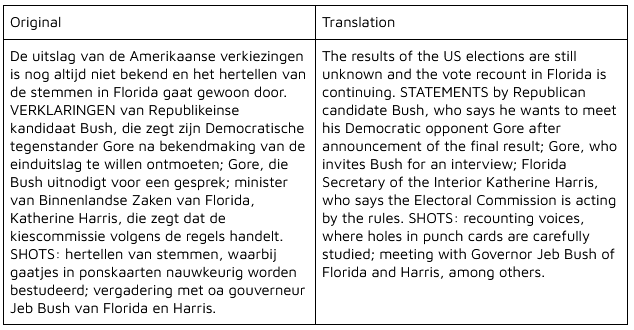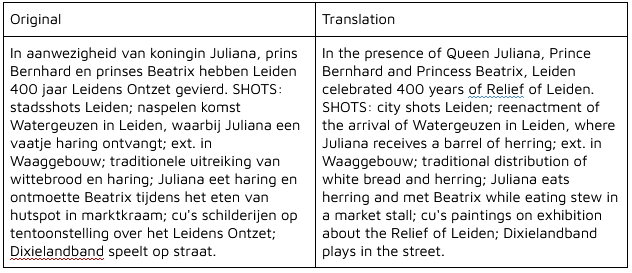The problem of doing research with the Media Suite in English has two layers: firstly, of course, the majority of the data itself is Dutch-language. This makes it difficult for researchers with a limited grasp of the Dutch language to work with the data in the Media Suite. Secondly, then there are sources in which the English language appears, but where the metadata is still in Dutch. These could include news items where English footage is used and subtitled, English programs that are broadcasted on Dutch television with subtitles, or Oral History interviews with a non-native Dutch interviewee that is conducted in English. This data could very well be used by researchers, but since the data has been metadated in Dutch, and the language is often not specified, finding these English-language items is made very hard.
A possible solution to finding English collection items with Dutch metadata in the Media Suite could be automatic translation, such as Google Translate. Through the years, this software has become more and more accurate in translating text data in some areas, while still coming up very short in other areas. This page presents an overview of the result of tests with Using Google Translate in the Media Suite in two directions. First, Google translate was used to translate search queries from English to Dutch before entering them in the Media Suite search bar. Second, the metadata of collection items findable using English search terms was translated from Dutch to English.
Translating search queries from English to Dutch
The result of this experiment has been that using Google Translate for translating search queries before entering them is quite unreliable. Let us start with some examples of this unreliability.

As one can see, Google Translate can be quite unreliable in the translation of short, incomplete phrases to use as search queries. As a researcher, it is important for search queries to yield accurate, repeatable and tweakable results from a search query, and using and using automatic translation for this purpose is quite frustrating, as you have far less control over the specifics of your search query. When one does not or barely speak Dutch, it is impossible to see the nuance in translation that could yield very different results.
#Translating titles and description from Dutch to English
When translating an item’s description and titles, accuracy and nuance are less important to a researcher, as the description is not meant to give a complete idea of the content. Additionally, the language that is being translated to is natural to the researcher, making it easier to catch translation mistakes. It also helps that item descriptions are quite a bit longer than search queries, giving Google Translate more context and thus a better translation result. Let us look at some examples.
This first translation the description from a broadcast of “Internationale Nieuwsuitwisseling” or International News Exchange. What these news exchanges fully entail is not clear, but they do offer quite a bit of English-language footage. This item was found using the search term “Florida Recount” (referring to the close election results in Florida in November 2000, where Bush was eventually declared victorious over Gore by the Supreme Court) between the dates of october 1st 2000- january 31st 2001. In contrast to the previous experiment, this translation is quite usable for a researcher to get an idea of the contents of the footage.

Let us look at a second example, this time a description of something culturally unique to the Netherlands, as to make it harder for Google Translate. I searched using the query “Leidens Ontzet”, Relief of Leiden in English, a tradition in Leiden where on 3 october the 1574 relief from the Spanish army is celebrated. While the translation of the description from a Polygoonjournaal broadcast leaves some words in the Dutch language, and the translation of “hutspot” to “stew” erases some context, this translation could still give an English researcher enough context to decide whether to bookmark the item for further review.

Conclusion
While the use of Google Translate in generating Dutch search queries is quite unreliable, the automatic translations of descriptions of items in the Media Suite would help many English-language researchers navigate through search results. Perhaps in the future, this function could be incorporated into the Media Suite itself: similarly to Twitter or Facebook, a small “Translate to English” button at the bottom of the description could ease the translation process and make the Media Suite more accessible to English users. Right now, however, using Google Translate externally to the Media Suite is a small effort and can most likely really help English researchers navigate Dutch metadata.